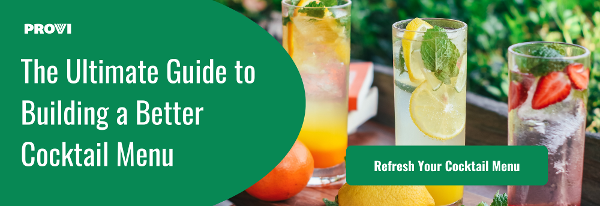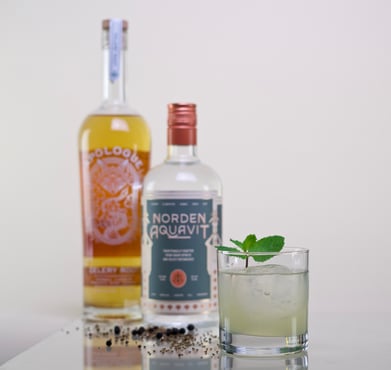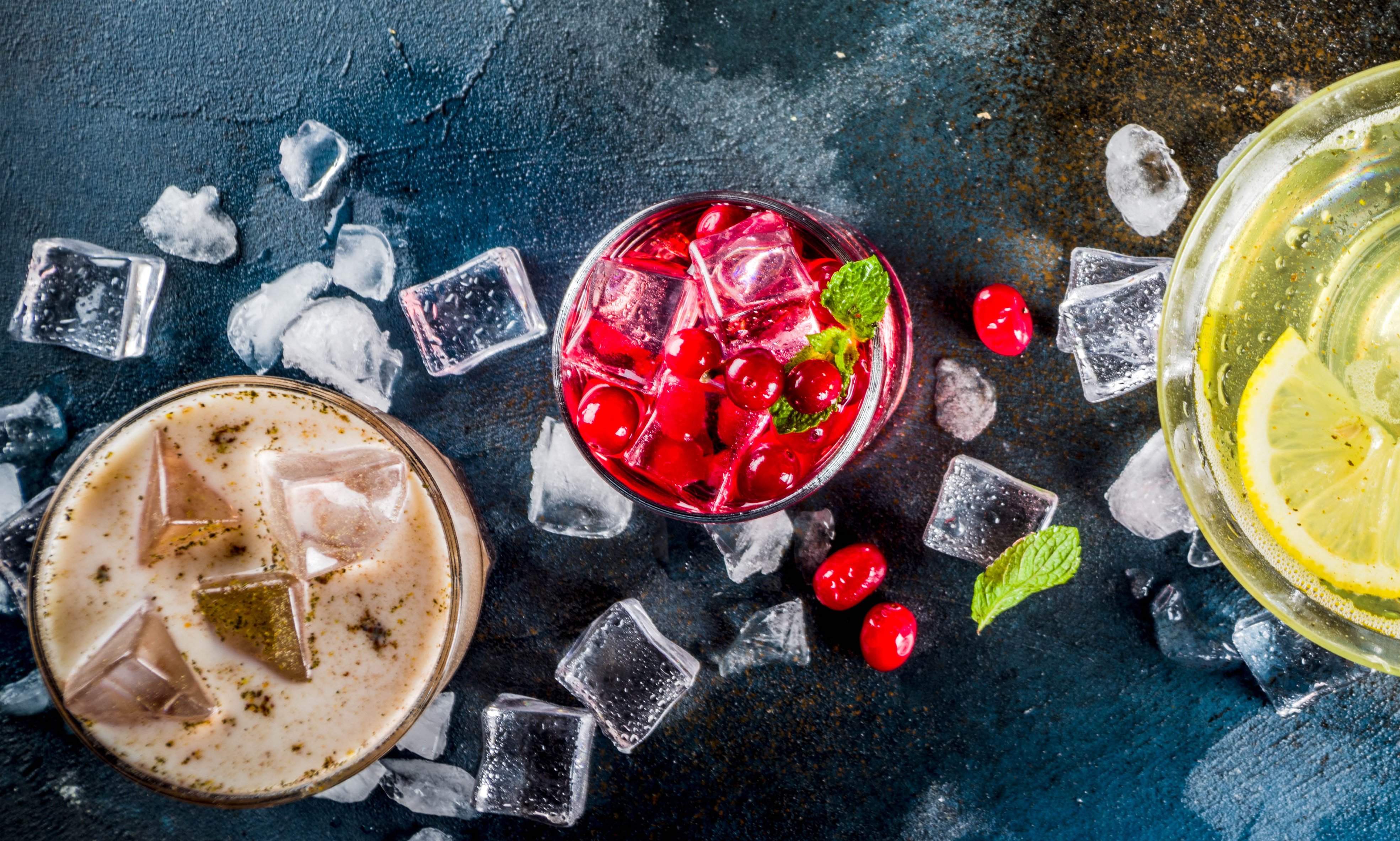Starting to think about writing your next (or first) cocktail menu? Congrats! Many bartenders spend years trying to get this privilege, so it’s definitely something to celebrate. But where do you go from here? And how do you begin? Below are some actionable tips to help you generate some much-needed inspiration.
Looking to update your seasonal cocktail menus? Download The Provi Guide to Building a Better Cocktail Menu.
The Cocktail Menu Concept
First and foremost, a good cocktail menu should reinforce the concept of your establishment. Whether it’s a neighborhood bar serving a handful of re-imagined classics or a farm-to-table restaurant, the drinks should speak to the overarching theme. Even a shot and beer bar can have a great cocktail menu. What’s important is understanding the space, the food, the audience and the atmosphere, as each of these factors affects the experience and must be considered.
Start by finding that common thread—the thing that runs through multiple layers of the guest experience. This can help strengthen your bar or restaurant’s brand identity while simultaneously creating a lasting impression on your guests. That’s the ultimate goal, right?
 If your bar hosts pool tournaments or frequently features late-night shows, do you think it’s an ideal spot for an 8-touch tiki cocktail? We think not. While possibly delicious, without other elements to reinforce it, the concept will come across as novel at best. And you don’t want that, do you?
If your bar hosts pool tournaments or frequently features late-night shows, do you think it’s an ideal spot for an 8-touch tiki cocktail? We think not. While possibly delicious, without other elements to reinforce it, the concept will come across as novel at best. And you don’t want that, do you?
What you want is a thoughtful list of familiar-feeling (yet elevated) classics. This can help raise the public perception of your program. Not only that, but it most certainly will differentiate your bar from others nearby.
Who's Drinking Your Cocktails?
Remember, you are making drinks for your guests. A good cocktail menu should always include a wide variety of ingredients and flavor profiles within the general parameters of your concept.
The cocktails should range from accessible to adventurous, and menus should be laid out in a way that enables guests to easily narrow in on what drink they are most likely to enjoy. It’s great to have a little something for everybody, but we recommend leaning toward the middle. You want mostly accessible cocktails with something in the mix for those who might be feeling adventurous.
People’s tastes vary wildly. Some like ‘em shaken, some like ‘em stirred and others might still be learning what they like. Keep that in mind—the menu needs to be easy to navigate. Your goal is to give everyone the best experience possible. Nobody wants to feel stressed out or overwhelmed when choosing a drink. Anything you can do to make the cocktail selection process easier is better.
From experience, guests that are interested in trying a craft cocktail tend to consider either their preference for base spirit or the intensity of the cocktail when ordering.
With longer menus, grouping the drinks by the base spirit can work well. If your menu has only a handful of drinks, try listing them in order of intensity - starting with the lightest and most refreshing and ending with more spirit-forward sippers. In either of the above scenarios, tasting notes or other visual indicators can be very helpful. Design and illustrations can also be great tools!
The Drinks
Start with a rough sketch. Build out your concepts and choose what ingredients you want to be featured on your menu. Don’t forget to think about seasonality and accessibility.
After you’ve sketched out your ideas, address any unintentional overlap in products used, garnishes, glassware or flavor profile. Sometimes, the best way to do this is to make all the cocktails in one session and line them up on the bar. (Make it a point to gather your team to taste-test!) By looking at them side-by-side, you get to see your menu come to life and can quickly assess its integrity.
If there are drinks that look too similar to one another, you can try switching up the serving vessel or garnishes to better differentiate them. Watch out for over-using a certain glass! Do you have the inventory to handle it? This is the time to take everything into consideration. Even down to the ice. Do you have too many drinks calling for a certain cube? Another thing to ask yourself—are they all the same color? This could lead to drinks hitting the wrong table and you really don’t want that to happen on your busiest day of the week.
Another thing to consider? Execution. It’s essential that you and your team can make these drinks on even your busiest night. Remember that the preparation of syrups, bitters and extra ingredients requires time and labor costs.
Cocktail Menu Costs
Last, but not least, you need to be considering the economics of the overall business. Calculate your costs for each drink and evaluate. Is there an ingredient that is too expensive? Hard to source? Could you switch out your base spirit to another, less expensive brand?
Your liquor cost is the amount of money you spend to generate each dollar in sales. For example, if your Daiquiri cost $1.50 to make and sells for $12, then your liquor cost for that drink is 12.5%. In other words, for every dollar of sales generated by that drink, your cost is 12.5 cents. Targets for cost percentage usually range between 15-25% depending on how the business is structured.
Bring the Cocktail Menu All Together
Let’s make it real. What’s an elevated classic cocktail, featuring readily available (yet seasonal) ingredients, that can fit in anywhere from a neighborhood bar, to a farm-to-table restaurant, to a fine dining establishment? Oh and keep costs below 25% for a $12 cocktail?
How about the “North Side?" A contemporary twist on one of our favorite classic cocktails the “South Side.” Traditionally made with gin, mint, simple syrup and lime juice, the South Side is a damn fine drink in its own right. Swap the gin out for a Michigan-made aquavit, add a little Apologue Celery Root, switch up your citrus, and now you’ve got something extraordinary.
The North Side ($2.47 cost)
 INGREDIENTS
INGREDIENTS- 1.50 oz Norden Aquavit ($1.48)
- 0.50 oz Apologue Celery Root ($0.52)
- 0.75 oz Lemon Juice ($0.18)
- 0.25 oz Simple Syrup ($0.06)
- Glass: Rocks ($0.07)
- Ice: Yes ($0.05)
- Garnish: Mint Sprig ($0.10)
DIRECTIONS
- Shake and strain into a rocks glass over ice and garnish with a mint sprig



Comments